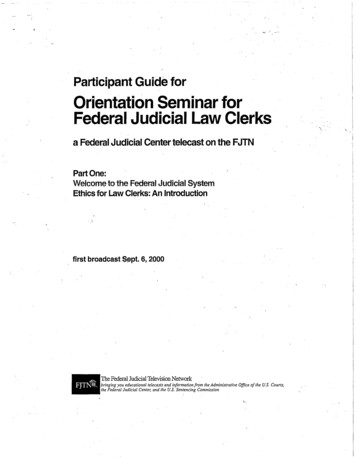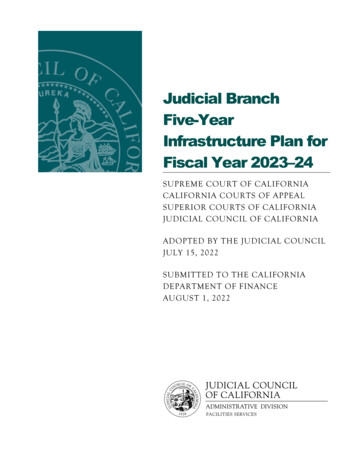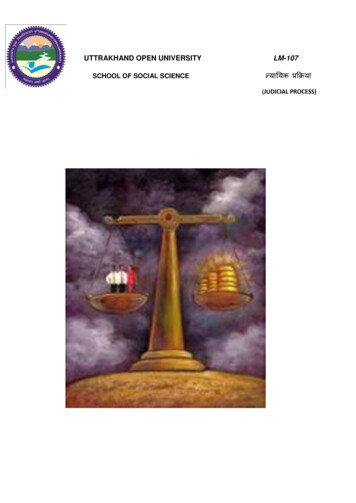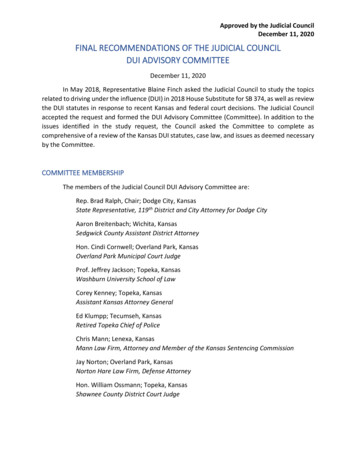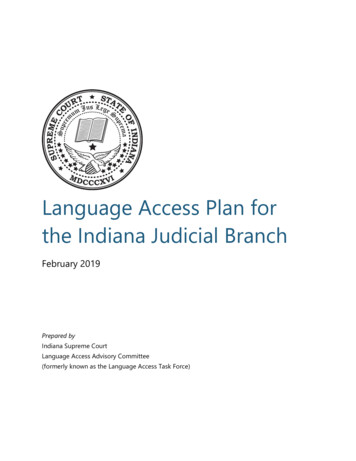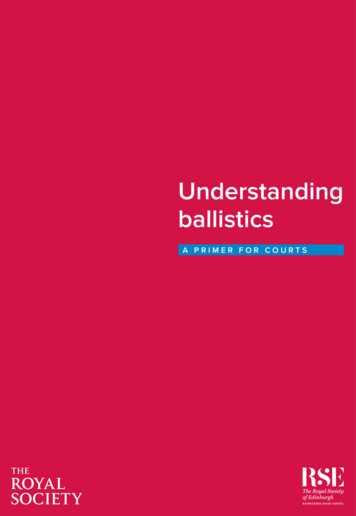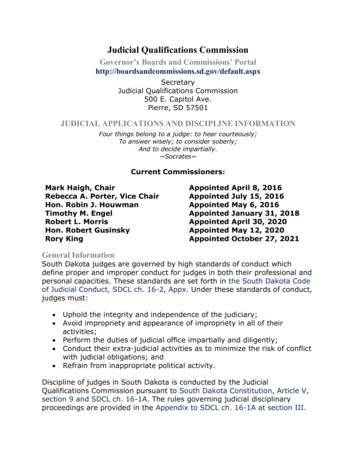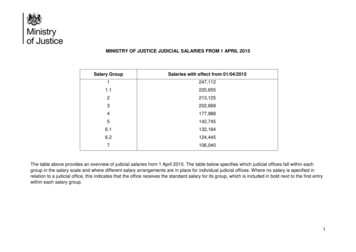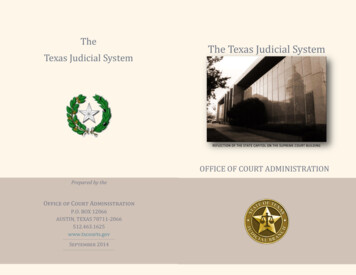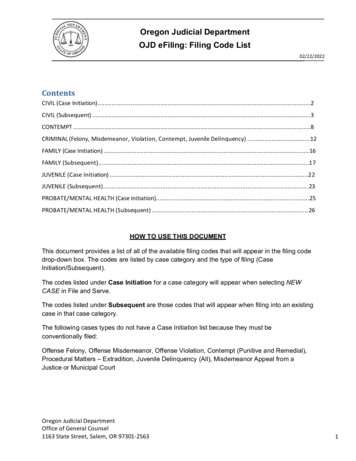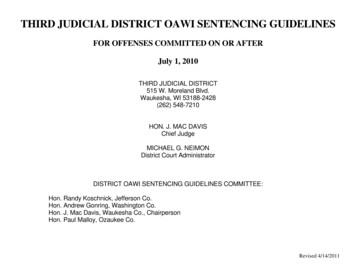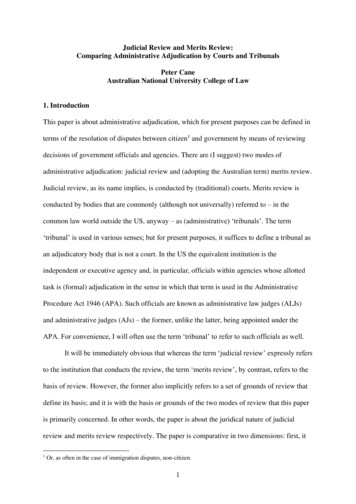
Transcription
Judicial Review and Merits Review:Comparing Administrative Adjudication by Courts and TribunalsPeter CaneAustralian National University College of Law1. IntroductionThis paper is about administrative adjudication, which for present purposes can be defined interms of the resolution of disputes between citizen1 and government by means of reviewingdecisions of government officials and agencies. There are (I suggest) two modes ofadministrative adjudication: judicial review and (adopting the Australian term) merits review.Judicial review, as its name implies, is conducted by (traditional) courts. Merits review isconducted by bodies that are commonly (although not universally) referred to – in thecommon law world outside the US, anyway – as (administrative) ‘tribunals’. The term‘tribunal’ is used in various senses; but for present purposes, it suffices to define a tribunal asan adjudicatory body that is not a court. In the US the equivalent institution is theindependent or executive agency and, in particular, officials within agencies whose allottedtask is (formal) adjudication in the sense in which that term is used in the AdministrativeProcedure Act 1946 (APA). Such officials are known as administrative law judges (ALJs)and administrative judges (AJs) – the former, unlike the latter, being appointed under theAPA. For convenience, I will often use the term ‘tribunal’ to refer to such officials as well.It will be immediately obvious that whereas the term ‘judicial review’ expressly refersto the institution that conducts the review, the term ‘merits review’, by contrast, refers to thebasis of review. However, the former also implicitly refers to a set of grounds of review thatdefine its basis; and it is with the basis or grounds of the two modes of review that this paperis primarily concerned. In other words, the paper is about the juridical nature of judicialreview and merits review respectively. The paper is comparative in two dimensions: first, it1Or, as often in the case of immigration disputes, non-citizen.1
compares the two modes of review, and secondly it compares the two modes of review inthree jurisdictions – the US, the UK and Australia.The jurisdictional comparison will pivot on Australia for two main reasons. First,understanding administrative adjudication requires an analysis of its constitutionalfoundations; and Australian federal constitutional law is a complex amalgam of British andAmerican elements. Secondly, the concept of ‘merits review’ – in the sense of the mode ofadministrative adjudication conducted by non-courts – has a complex and highly developedtechnical meaning in Australian law that it lacks in the law of either the US or the UK. As aresult, a much more sophisticated understanding of the juridical nature of ‘non-judicial’review can gained by analysing Australian law than by studying the law of either the US orthe UK.2Outside Australia, there is surprisingly little literature about the nature of non-judicialreview. Administrative lawyers in all three of our comparator jurisdictions tend to focus onjudicial review and to marginalise tribunals and merits review. Discussion of tribunals tendsto be concerned primarily with issues such as procedure and independence. It is generallyacknowledged that tribunals are of great practical significance, if only because they resolvemany more disputes between citizen and government than do courts; but they are rarelyconsidered to be of much theoretical interest. This is partly because of the high status and theconstitutional significance of courts; and partly because of the fact that in the US and the UKtribunals are commonly (but often unthinkingly) thought of as performing an essentiallysimilar function to that of courts. In Australia, by contrast, tribunals are understood to beessentially different institutions from courts and to perform an essentially different functionthan courts. In fact – as we will see – in Australian law there are significant similarities2The most comprehensive account of merits review in Australia is D Pearce, Administrative Appeals Tribunal,2nd edn (LexisNexis Butterworths Australia, 2007). The research on which this paper is based was generouslyfunded by the Australian Research Council. It draws on material in P Cane, Administrative Tribunals andAdjudication (Oxford: Hart Publishing, 2009), forthcoming.2
between the two modes of administrative adjudication; and in US and UK law there are,arguably, significant differences between them. Exploring such similarities and difference isa major aim of this paper.The remainder of the paper is divided into four sections. Section 2 examines thedevelopment and meaning of the Australian concept of merits review. Sections 3 and 4 dealwith the position in the UK and the US respectively, and section 5 draws together thediscussion in the previous three sections and suggests that the characteristic function oftribunals in all three of our comparator jurisdictions is intense review of bureaucratic factfinding.2. Australia2.1 The Development of Merits ReviewLike much else, Australia borrowed the basic model of the administrative tribunal fromEngland. The model administrative tribunal is a free-standing adjudicatory body that reviewsdecisions, made by the executive branch of government, which adversely affect citizens.Unlike the English constitution, however, the Constitution of the Commonwealth of Australia(the federal level of government) is contained in a single document and embodies, like theUS Constitution, a formal separation of powers: Chapter I deals with the legislature, ChapterII with the executive and Chapter III with the judiciary. However, the Constitution alsoestablishes a system of responsible government in which ministers of state are required to bemembers of parliament (s 64); and for historical and pragmatic reasons, delegation oflegislative power to the executive has been held to be consistent with the Constitution.3 Onthe other hand, the Constitution has been interpreted as requiring a rather strict separation ofjudicial power. The ‘dominant principle of demarcation’4 is that only Chapter III courts can34Victorian Stevedoring and General Contracting Co Pty Ltd v Dignan (1931) 46 CLR 73.New South Wales v The Commonwealth (the ‘Wheat case’) (1915) 20 CLR 54, 90 (Isaacs J)3
exercise judicial power, and that Chapter III courts cannot perform non-judicial functionsexcept those that are incidental to the exercise of judicial power.5In a series of cases in the 1920s – commonly called ‘the taxation cases’6 – the HighCourt of Australia (and the English Privy Council on appeal from the High Court) wereconfronted by challenges to the constitutionality of the system for adjudicating disputesbetween taxpayers and the tax authorities. Taxpayers were originally given the choice ofchallenging determinations of the Commissioner of Taxation either in a Chapter III court orbefore a Taxation Board of Appeal, which was not a Chapter III court. Various features ofthis arrangement – such as the fact that there was a right of appeal from the Board to the HighCourt in its appellate jurisdiction – were held by the High Court to involve unconstitutionalconferment of judicial power on the Board of Appeal. The relevant legislation wassubsequently amended to replace the Board of Appeal with a Board of Review. Criticalfeatures of the new arrangement were that in reviewing determinations of the Commissioner,the Board was expressed to have ‘all the powers and functions’ of the Commissioner, and thedecision of the Board was deemed to be a decision of the Commissioner. Partly on this basis,it was held by both the High Court and the Privy Council that in adjudicating disputesbetween taxpayers and the Commissioner, the Board of Review was exercising non-judicialpower with which, being a non-judicial body, it was validly invested.Perhaps the chief significance of the taxation cases was that they cleared the way forthe use of non-judicial tribunals to adjudicate disputes between citizen and government, thusproviding much-needed supplementation of the relatively meagre adjudicatory resourcesavailable in the then-existing Chapter III courts. As acknowledged by Isaacs J who was,R v Kirby; Ex parte Boilermakers’ Society of Australia (1956) 94 CLR 254; affirmed on appeal by the PrivyCouncil: Attorney-General (Commonwealth) v R; Ex parte Boilermakers’ Society of Australia (1957) 95 CLR529.6British Imperial Oil Co Ltd v Commissioner of Taxation (1925) 35 CLR 422; Federal Commissioner ofTaxation v Munro (1926) 38 CLR 153; Shell Co of Australia Ltd v Federal Commissioner of Taxation (1930) 44CLR 530.54
ironically, the chief architect of the dominant principle of demarcation,7 the rapid growth ofgovernment involvement in economic and social life in the early 20th century (coupled withan unwillingness to swell the ranks of the Chapter III judiciary by creating new courts) maderecognition of the constitutionality of arrangements for non-judicial administrativeadjudication a practical necessity.8The decisions in the taxation cases were based on the principle that judicial functionscannot be conferred on non-judicial bodies. The corollary (and more controversial) principle,that non-judicial functions cannot be conferred on judicial bodies unless incidental to theexercise of judicial power, was not established until 1957.9 The latter principle underpinnedreasoning central to the 1971 Report of the Commonwealth Administrative ReviewCommittee (the ‘Kerr Committee’).10 The Committee was established primarily to consider aproposal for a new federal court to review ‘administrative decisions’. Its recommendations inthis regard led to the creation of the Federal Court of Australia in 1976 and the enactment ofthe Administrative Decisions (Judicial Review) Act 1976, which created a statutory regime ofjudicial review alongside the existing common law regime. However, the Committee alsoconsidered that because judicial review was concerned only with the ‘legality’ ofadministrative decisions, it needed to be supplemented by general provision for review ofdecisions ‘on the merits’. In the Committee’s opinion, reviewing the merits of administrativedecisions (as opposed to their legality) would typically involve the exercise of non-judicialpower. It followed that the merits review function could not be conferred on a judicial body.The Committee therefore recommended the creation of a (non-judicial) generaladministrative appeals tribunal on which would be conferred power to review the ‘merits’ ofa wide range of administrative decisions. Although the Committee did not explicitly7See n 2 aboveSee particularly Isaacs J’s judgment in Federal Commissioner of Taxation v Munro.9See n 3 above.10Parliamentary Paper No 144 of 1971.85
recognise the fact, it had invented a new adjudicatory function – merits review – which, beinga non-judicial, was to be understood as categorically different from judicial review, a judicialfunction.The model adopted for the Administrative Appeals Tribunal (AAT) was that of theTaxation Board of Review, approved by the High Court and the Privy Council 50 yearsearlier. On review, the AAT has the power to affirm or vary a decision or to set it aside andmake a substitute decision or remit it to the decision-maker for reconsideration.11 The AAT‘may exercise all the powers and discretions that are conferred by any relevant enactment onthe person who made the decision’; and when the AAT varies a decision or makes asubstitute decision, its decision is deemed to be the decision of the original decision-maker.Out of these sparse provisions the AAT and the Federal Court have developed a complexconcept of merits review that describes the main function of the AAT and other federaladministrative tribunals that operate in areas such as social security and immigration. TheAAT exercises a mix of first-tier and second-tier merits review jurisdiction. The formerinvolves reviewing decisions of bureaucrats and the latter involves reviewing (on theirmerits) decisions of first-tier (merits review) tribunals (such as social security appealtribunals but not, notably, immigration tribunals). Decisions of the AAT can be appealed tothe Federal Court on a point of law, and the AAT is subject, in theory at least, to judicialreview by the Federal Court.The extent to which the concept of merits review has taken on a life of its own iswitnessed by its adoption in the Australian states. Unlike the Commonwealth Constitution,the constitutions of the states do not embody a formal separation of powers. As a result, thereis, in principle, no bar to the conferral of non-judicial power on state courts or to the conferral11Administrative Appeals Tribunal Act 1975 (AAT Act), s 43.6
of judicial power on state tribunals.12 It might be expected, therefore, that the distinctionbetween judicial review and merits review would find no place in state law. However, thereare various state adjudicatory bodies – some called ‘tribunals’ and others called ‘courts’ –that exercise a mix of judicial review and merits review jurisdiction. In the state context, theconcept of merits review is essentially similar to that developed by the AAT and the FederalCourt at the federal level. In Australian law, at both federal and state level, merits review hascome to be understood as describing a mode of administrative adjudication distinct anddifferent from judicial review.2.2 The Concept of Merits ReviewThe concept of merits review can be said to have three elements, which might loosely becalled the substantive, the procedural and the remedial. The substantive element isencapsulated in the principle that the task of a merits reviewer is to ensure that the ‘correct orpreferable’ decision is made.13 The procedural element is colloquially captured in the ideathat the merits reviewer ‘stands in the shoes of the primary decision-maker’. The remedialelement relates to the powers of the merits reviewer when it reviews a decision.2.2.1 The Substantive Element of Merits ReviewAlthough the Kerr Committee (perhaps unwittingly) invented the concept of merits review, itsaid very little about its nature beyond contrasting review on the merits with legality-basedreview. Similarly, the Administrative Appeals Tribunal Act 1975 (AAT Act) (like subsequentstatutes modelled on it) contains no indication of the criteria according to which the AATshould exercise its various remedial powers. The ‘correct or preferable’ standard of meritsreview – which is a judicial invention14 – refers, in abstract terms, to norms of good decisionmaking departure from which triggers the remedial jurisdiction of the AAT and application of12Indeed, the categorical distinction between judicial bodies (courts) and non-judicial bodies (tribunals) foundin federal law is absent from state law.13Drake v Minister for Immigration and Ethnic Affairs (1979) 2 ALD 60, 68 (Bowen CJ and Deane J).14See previous note.7
which underpins exercise by the AAT of its various remedial powers, and in particular thepowers to vary a decision and to make a substitute decision. ‘Correct’ in this formula is takento refer to situations in which the reviewer considers that there is only one acceptabledecision; and ‘preferable’ refers to situations where it considers that there is more than oneacceptable decision.In an early decision of the AAT, its first President (Brennan J) said that ‘[t]here is nodichotomy between the administrative standards upon which the Tribunal must insist andthe principles of law which are applied by a court : administrative action which exceeds thepower conferred is not only ineffective in point of law, but it constitutes unacceptableadministrative conduct’.15 Thus, a merits reviewer may intervene if it considers that theprimary decision was not the correct or preferable one as a result of procedural unfairness, orof some defect of reasoning – such as taking account of an irrelevant consideration orexercising a power for an improper purpose, or because the decision-maker made an error oflaw or fact, or because the decision was unreasonable. Because these are all grounds ofjudicial review as well as triggers for the exercise of the remedial powers of a meritsreviewer, the question that inevitably arises is whether there are any substantive differencesbetween judicial review and merits review. Three issues deserve some attention: review ofgovernment policy, review for error of law and review for error of fact.2.2.1.1 Policy ReviewIn this context, policies are non-statutory decision-making norms. In Australian judicialreview law, a decision may be illegal if it is based on a policy that is inconsistent with a ruleof law, or on application of a policy without proper regard to the facts of the particular case,16or on refusal to apply an announced policy without good reason.17 A decision may also beheld illegal if it is based on a policy that the court considers to be ‘so unreasonable that no15Re Brian Lawlor Automotive and Collector of Customs (1978) 1 ALD 167, 177.Policies, lacking the force of law, must be applied flexibly.17At least, without giving the affected person a chance to argue for the application of the policy.168
reasonable decision-maker could apply it’. This is known as ‘Wednesbury unreasonableness’,and it sets a very high threshold for judicial intervention. In Australian merits review law, itis clear that such defects may justify the conclusion that a decision is not the correct orpreferable one. The more difficult question is whether a merits reviewer may intervene whenthe policy on which the decision is based, although not Wednesbury-unreasonable is,nevertheless, in the opinion of the reviewer, not the preferable one. In other words, how freeis a merits reviewer to depart from government policy in deciding whether a decision iscorrect or preferable? The doctrine of the separation of judicial power is taken to permitcourts to reject government policy only in extreme cases. However, merits reviewers exercisenon-judicial, and not judicial, power, and this fact may be thought to support greater freedomin judging the merits of government policy.Brennan J addressed such issues in one of the Tribunal’s earliest decisions. TheAAT’s powers, he said, are wide enough to ‘permit the sterilization or amendment ofpolicy in point of law, the Tribunal is as free as the Minister to apply or not to applypolicy [it] is at liberty to adopt whatever policy it chooses, or no policy at all’.18 On theother hand, Brennan J said, the Tribunal is essentially a ‘curial’, not an ‘administrative’body,19 and its basic responsibility is to apply policy, not make it. ‘The detachment which isdesirable for adjudication’, he added, ‘is not in sympathy with the purposiveness of policyformation’.20 In other words, although merits review tribunals are non-judicial bodies,because of their basically adjudicatory function, it is inappropriate for them to pronounceupon the merits of the policies on which decisions are based as opposed to the merits of thedecision itself relative to those policies. In practice, Australian merits reviewers are no morewilling than courts to question government policy. Indeed, in some of the Australian states,18Re Drake and Minister for Immigration and Ethnic Affairs (1979) 2 ALD 634, 642.Ibid, 643.20Ibid.199
there are statutory provisions designed to limit the freedom of merits reviewers to departfrom government policy.2.2.1.2 Error of LawIn Australian law, ‘merits review’ has become a highly technical concept. However, there isalso a less formal and more basic sense in which the ‘merits’ of a decision are contrasted withits ‘legality’. Legality is the province of judicial review while the merits (in this less formalsense) are the province of merits review. Theoretically, a decision that is lawful and, as aresult, immune from judicial review, may nevertheless not be the correct or preferable one, inwhich case it might open to a merits reviewer to vary the decision or make a decision insubstitution for it. Conversely, it might seem to follow that if a decision is unlawful, thequestion of whether it is the correct or preferable one would never arise: if a decision isillegal, whether it is good or bad is of no concern. So does a merits reviewer have jurisdictionto review an illegal (purported) decision and to set it aside on the ground that it is contrary tolaw (regardless of its merits)? This was one of the first questions that the AAT was requiredto answer; and the Tribunal’s decision that it did have such power21 established that althoughmerits reviewers (unlike courts exercising judicial review jurisdiction) can reviewadministrative decisions ‘on the merits’, this is not all they can do: they can also decidequestions of law.22More generally, the AAT’s decision established that judicial review and merits revieware, in their substantive dimension, overlapping rather than mutually exclusive functions.Merits review, we might say, is enhanced judicial review in the sense that (any and all of) thenorms of good decision-making departure from which can render a decision illegal can also21Re Brian Lawlor Automotive Pty Ltd and Collector of Customs (NSW) (1978) 1 ALD 167; affirmed Collectorof Customs (NSW) v Brian Lawlor Automotive Pty Ltd (1979) 2 ALD 1; reaffirmed Secretary, Department ofSocial Security v Alvaro (1994) 34 ALD 72.22However, merits review tribunals cannot answer questions of law ‘conclusively’, this being a judicialfunction. The exact meaning of this term is unclear, but it’s practical effect is that statements of law by meritsreview tribunals are a form of soft law.10
prevent it being the correct or preferable decision. On the other hand, it does not follow frmthe fact that a decision is lawful that it is also the correct or preferable decision.2.2.1.3 Error of FactThis conclusion is best and most clearly illustrated by reference to errors of fact which, in therelevant sense, result from giving too little or too much weight to the available evidence. Ingeneral, in Australian law such errors do not provide a ground for judicial review, whereasfailure to give appropriate weight to the evidence is one of the most important and commonjustifications for holdings by merits reviewers that the decision in question was not thecorrect or preferable one. Indeed, it has been said that one of the reasons why courts arerelatively unwilling to review fact-finding by administrators is precisely that doing so is oneof the prime functions of merits review tribunals.23 Moreover, in those types of case in whichcourts will review decisions on questions of fact, the tests used to determine whether or notthe decision is lawful tend to leave the decision-maker considerable discretion and to justifyholdings of illegality only in extreme cases. By contrast, the ‘correct or preferable’ formulaof merits review gives the reviewer much more freedom to reassess the evidence and itsweight. We saw in 2.2.1.2 that merits reviewers appear just as unwilling as courts to reviewbureaucratic policy-making. By contrast, reviewing bureaucratic fact-finding is understood tobe their core business.We may summarise the discussion of the substantive element of merits review bysaying that it is in the area of review of fact-finding that it differs most from judicial reviewand involves much greater external scrutiny of bureaucratic decision-making.2.2.2 The Procedural Element of Merits Review23Australian Broadcasting Tribunal v Bond (1990) 170 CLR 321, 340.11
Central to the concept of merits review is the idea that the reviewer ‘stands in the shoes of theprimary decision-maker’.24 This colloquialism paraphrases statutory provisions that allow thereviewer to exercise (any and all of) the powers and discretions vested in the primarydecision-maker and that deem the reviewer’s decision – when the reviewer varies the primarydecision or makes a substitute decision – to be the decision of the primary decision-maker.These provisions mark a fundamental difference between merits review and judicial review.Whereas the main function of the judicial reviewer is to examine the decision for defects andto invalidate the decision if it is defective, the main function of the merits reviewer is to bringit about that the correct or preferable decision is made. Like the judicial reviewer, the meritsreviewer may do this by affirming the original decision or remitting it to the primarydecision-maker for reconsideration. But very commonly, the merits reviewer will achieve therequired outcome by doing something that judicial reviewers typically have no power to do –namely varying the original decision or making a new decision in substitution for it. In doingso, the reviewer may exercise any relevant power available to the primary decision-makerwhether or not the latter purported to exercise that power in making the original decision.Nevertheless, despite its beguiling simplicity, the idea that the reviewer stands in theshoes of the primary decision-maker is complex and problematic. For one thing, when amerits reviewer affirms the primary decision or sets it aside and remits it to the primarydecision-maker for reconsideration, the reviewer exercises a power of its own, not a power ofthe original decision-maker. More significantly, a tribunal typically has much more time andmany more resources to devote to reviewing the decision than bureaucrats can typicallydevote to individual cases. Moreover, merits review is conducted not on the basis of therelevant facts as they were at the date the primary decision was made but on the basis of therelevant facts as at the date of review (in other words, the record remains open until the date24Minister for Immigration and Ethnic Affairs v Pochi (1980) 4 ALD 139, 143 (Smithers J)12
of review and the reviewer can receive new evidence that was not available to the primarydecision-maker). Under certain circumstances, the merits reviewer can even take account ofchanges in the law since the original decision was made.Unless used carefully, there is a danger that the shoe metaphor will blind us to suchdistinctions between primary decision-making and merits review, and cause‘misunderstanding between decision-makers and reviewers’25 based on lack ofappreciation of the significant differences between the respective roles of the former and thelatter.2.2.3 The Remedial Element of Merits ReviewAs we have seen, a merits reviewer may affirm or vary the decision under review, or set thedecision aside and either make a substitute decision or remit the decision to the primarydecision-maker for reconsideration. In practice, the archetypal merits review remedy is to setthe decision aside and make a substitute decision. Merits reviewers rarely remit decisions forreconsideration, and in principle should do so only if the reviewer considers that the primarydecision-maker is in a better position than the reviewer to make the correct of preferabledecision. By contrast, the archetypal judicial review remedy is setting aside and remittal tothe primary decision-maker. This difference reflects the fact that courts are judicial bodiesexercising judicial power while merits review tribunals are non-judicial bodies exercisingnon-judicial power. The power to make a decision in substitution for that of an executiveofficer or agency (as opposed to a lower court) is, in theory, a non-judicial power, and socould not (in principle, at least) be conferred on a court.26S Hamilton, ‘The Future of Public Administration: The Future of Administrative Law’ in R Creyke and JMcMillan (eds), The Kerr Vision of Australian Administrative Law – At the Twenty-Five Year Mark (Canberra:Centre for International and Public Law, 1998), 118.26There is a right of appeal ‘on a question of law’ from the AAT to the Federal Court. Such an appeal isfunctionally equivalent to a judicial review application and engages the original, not the appellate, jurisdictionof the court. The Federal Court has no express power to make a decision in substitution for that of the AAT, andit rarely does so. Since 2005 it has had power to make findings of fact that are consistent with the findings of theAAT and, for that purpose, to admit new evidence. The constitutionality of these provisions, and of the FederalCourt’s occasional practice of making a decision in substitution for that of the AAT, have not been tested.2513
In Australian federal law, an important difference between courts (judicial reviewers)and tribunals (merits reviewers) arises from the fact that the power to make enforceabledecisions is considered to be judicial. It follows that tribunals, being non-judicial bodies,cannot be given the power to enforce their own decisions; and also that in enforcementproceedings before a court, the tribunal’s decision must be ‘reviewed’ by the court.272.3 Merits Review and Judicial ReviewWe can summarize the foregoing discussion by saying that because of the strong principle ofseparation of judicial power that the High Court has read out of (or in to) the AustralianConstitution, there is a categorical distinction in Australian law between judicial review andmerits review. This distinction is clearest in respect of what I have dubbed the procedural andremedial elements of merits review. The archetypal judicial review remedy is setting asideand remittal, while the archetypal merits review remedies are varying the decision andmaking a substitute decision. In dispensing the characteristic merits review remedy, thereviewer exercises by proxy powers available to the primary decision-maker, whereas indispensing the characteristic judicial review remedy courts exercise inherent judicial power.Judicial review is typically based on the material available, to and the reasons for decisiongiven by, the primary decision-maker, and on the law as it stood at the time the originaldecision was made.28 By cont
proposal for a new federal court to review 'administrative decisions'. Its recommendations in this regard led to the creation of the Federal Court of Australia in 1976 and the enactment of the Administrative Decisions (Judicial Review) Act 1976, which created a statutory regime of judicial review alongside the existing common law regime.
